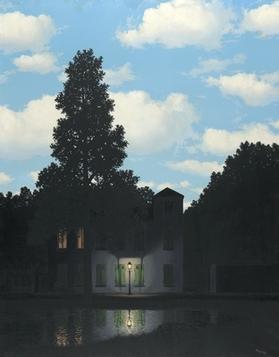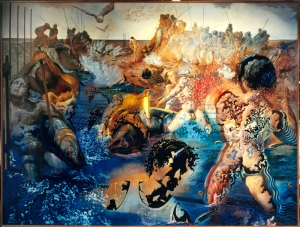
Pierre Teilhard de Chardin was a French Jesuit, Catholic priest, scientist, paleontologist, theologian, philosopher, and teacher. He was Darwinian and progressive in outlook and the author of several influential theological and philosophical books. His mainstream scientific achievements included taking part in the discovery of Peking Man. His more speculative ideas, sometimes criticized as pseudoscientific, have included a vitalist conception of the Omega Point and the development along with Vladimir Vernadsky of the concept of a noosphere.

Salvador Domingo Felipe Jacinto Dalí i Domènech, Marquess of Dalí of Púbol, known as Salvador Dalí, was a Spanish surrealist artist renowned for his technical skill, precise draftsmanship, and the striking and bizarre images in his work.
The Omega Point is a theorized future event in which the entirety of the universe spirals toward a final point of unification. The term was invented by the French Jesuit Catholic priest Pierre Teilhard de Chardin (1881–1955). Teilhard argued that the Omega Point resembles the Christian Logos, namely Christ, who draws all things into himself, who in the words of the Nicene Creed, is "God from God", "Light from Light", "True God from True God", and "through him all things were made". In the Book of Revelation, Christ describes himself three times as "the Alpha and the Omega, the beginning and the end". Several decades after Teilhard's death, the idea of the Omega Point was expanded upon in the writings of John David Garcia (1971), Paolo Soleri (1981), Frank Tipler (1994), and David Deutsch (1997).

The Swallow's Tail — Series of Catastrophes was Salvador Dalí's last painting. It was completed in May 1983, as the final part of a series based on the mathematical catastrophe theory of René Thom.

La Desintegración de la Persistencia de la Memoria or The Disintegration of the Persistence of Memory is an oil on canvas painting by the Spanish surrealist Salvador Dalí. It is a 1954 re-creation of the artist's famous 1931 work The Persistence of Memory, and measures a diminutive 25.4 × 33 cm. It was originally known as The Chromosome of a Highly coloured Fish's Eye Starting the Harmonious Disintegration of the Persistence of Memory, and first exhibited at the Carstairs Gallery in New York in 1954.
Brian Thomas Swimme is a professor at the California Institute of Integral Studies, in San Francisco, where he teaches evolutionary cosmology to graduate students in the philosophy, cosmology, and consciousness program. He received his Ph.D. (1978) from the department of mathematics at the University of Oregon for work with Richard Barrar on singularity theory, with a dissertation titled Singularities in the N-Body Problem.

Edward Frank Willis James was a British poet known for his patronage of the surrealist art movement.
Albert Skira (1904–1973) was a Swiss art dealer, publisher and the founder of the Skira publishing house.

Young Virgin Auto-Sodomized by the Horns of Her Own Chastity is a 1954 painting by Salvador Dalí. During the 1950s, Dalí painted many of his subjects as composed of rhinoceros horns. Here, the young virgin's buttocks consist of two converging horns and two horns float beneath; "as the horns simultaneously comprise and threaten to sodomise the callipygian figure, she is effectively (auto) sodomised by her own constitution."

Christ of Saint John of the Cross is a painting by Salvador Dalí made in 1951 which is in the collection of the Kelvingrove Art Gallery and Museum, Glasgow. It depicts Jesus Christ on the cross in a darkened sky floating over a body of water complete with a boat and fishermen. Although it is a depiction of the crucifixion, it is devoid of nails, blood, and a crown of thorns, because, according to Dalí, he was convinced by a dream that these features would mar his depiction of Christ. Also in a dream, the importance of depicting Christ in the extreme angle evident in the painting was revealed to him.

The Phenomenon of Man is an essay by the French geologist, paleontologist, philosopher, and Jesuit priest Pierre Teilhard de Chardin. In this work, Teilhard describes evolution as a process that leads to increasing complexity, culminating in the unification of consciousness. The text was written in the 1930s, but it achieved publication only posthumously, in 1955.

Basket of Bread (1945) or Basket of Bread-Rather Death Than Shame is a painting by Spanish Surrealist Salvador Dalí. The painting depicts a heel of a loaf bread in a basket, sitting near the edge of a table. Dalí's use of bread in his paintings is said to contain messages about the political context at the time of the painting, his progression as an artist, and his societal beliefs.

Galatea of the Spheres is a painting by Salvador Dalí made in 1952. It depicts Gala Dalí, Salvador Dalí's wife and muse, as pieced together through a series of spheres arranged in a continuous array. The name Galatea refers to a sea nymph of Classical mythology renowned for her virtue, and may also refer to the statue beloved by its creator, Pygmalion.

The Ecumenical Council is a surrealist painting by Spanish artist Salvador Dalí completed in 1960. It is one of his masterpieces, taking two years to complete and very large at 299.7 by 254 centimetres. The painting is a complex assemblage of art historical references and religious scenes emphasizing Catholic symbolism.

Soft Construction with Boiled Beans (Premonition of Civil War) (1936) is a painting by the Spanish surrealist artist Salvador Dalí. Dalí created the piece to represent the horrors of the Spanish Civil War, having painted it only six months before the conflict began. He subsequently claimed that he was aware the war was going to occur long before it began, and cited his work as evidence of "the prophetic power of his subconscious mind." However, some have speculated that Dalí may have changed the name of the painting after the war to emphasize his prophetic assertions, although it is not entirely certain.

The Empire of Light is the title of a succession of paintings by René Magritte. They depict the paradoxical image of a nocturnal landscape beneath a sunlit sky. He explored the theme in 27 paintings from the 1940s to the 1960s. The paintings were not planned as a formal series. They have never all been exhibited together and are rarely exhibited in smaller groups. The original French title, L'Empire des Lumieres is sometimes translated as singular, The Empire of Light,and sometimes as plural The Empire of Lights. Other translations include The Dominion of Light: making the distinction: "an empire exists in relation to a ruler, a dominion does not necessarily require this.”

Lincoln in Dalivision is a 1977 original limited edition lithograph created by Salvador Dalí. It is often considered one of the most counterfeited Dalí lithographs. Dalí authentication experts who have noted the counterfeiting issue with this work include Albert Field, Frank Hunter, Robert Descharnes and Bernard Ewell. Lee Catterall comments in his book The Great Dalí Art Fraud & other deceptions, "The painting most commonly reproduced for such fraudulent purposes was Lincoln in Dalivision, 'prints' of which Los Angeles art appraiser Dena Hall testified in the Hawaii trial have become as commonplace as 'pancakes at the pancake house.'"

The Colossus of Rhodes is a 1954 oil painting by the Spanish surrealist Salvador Dalí. It is one of a series of seven paintings he created for the 1956 film Seven Wonders of the World, each depicting one of the wonders. The work shows the Colossus of Rhodes, the ancient statue of the Greek titan-god of the sun, Helios. The painting was not used for the film and was donated to the Kunstmuseum Bern in 1981, where it remains.
The Enigma of Hitler is an oil on canvas painting by Salvador Dalí, created in 1939. It was made around the time of his expulsion from the Surrealist movement.














